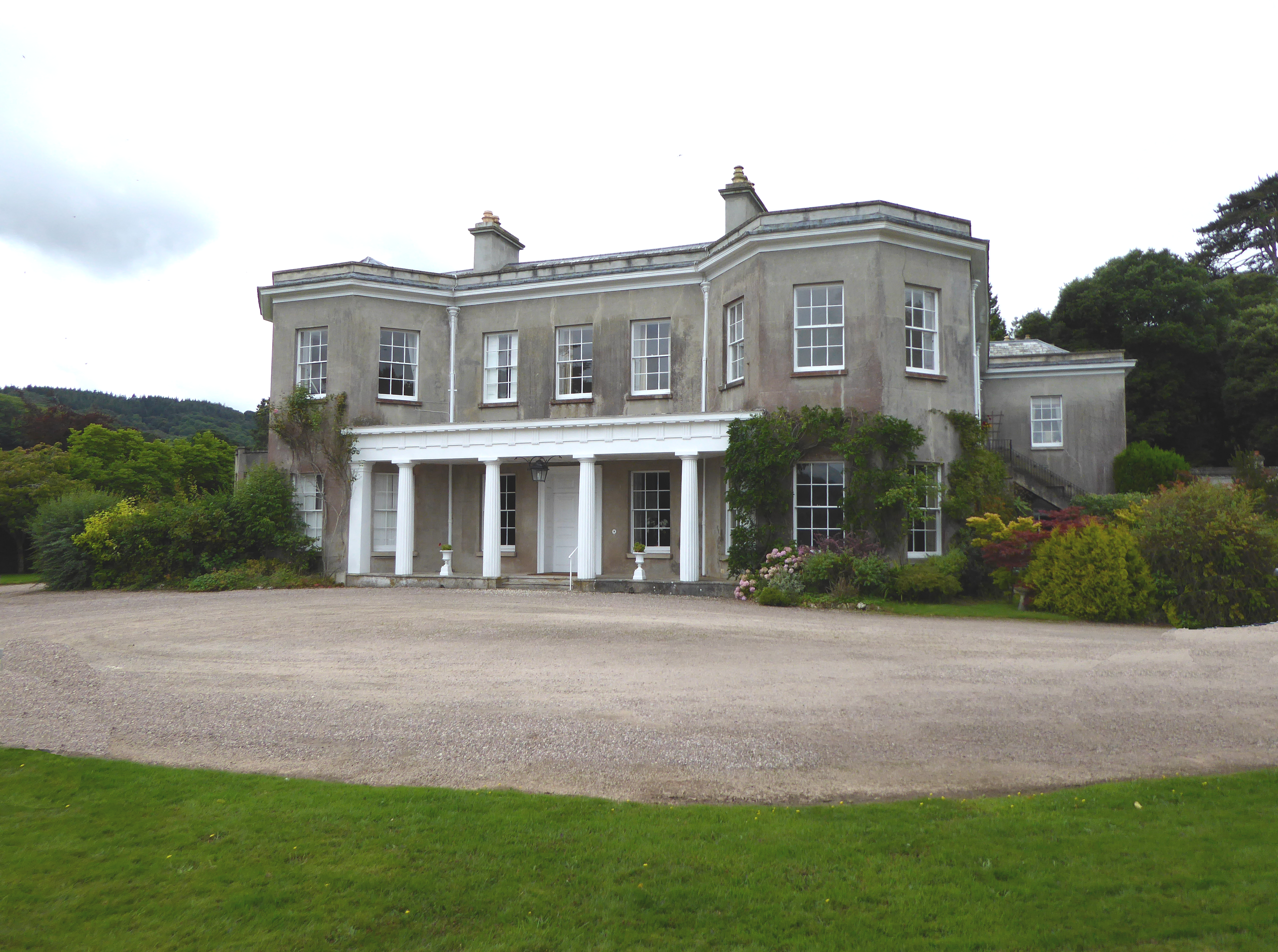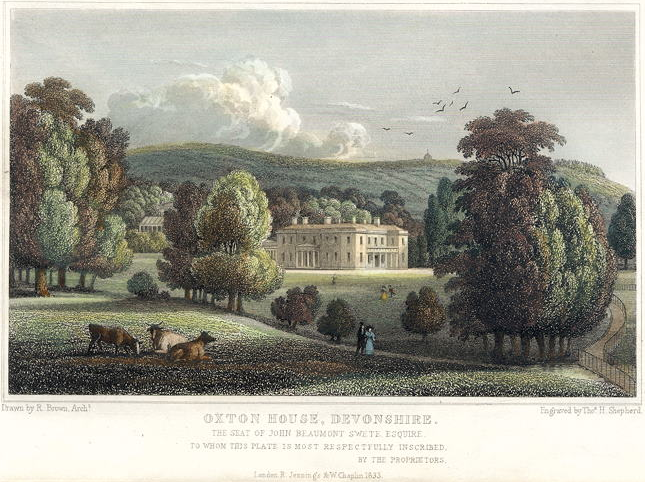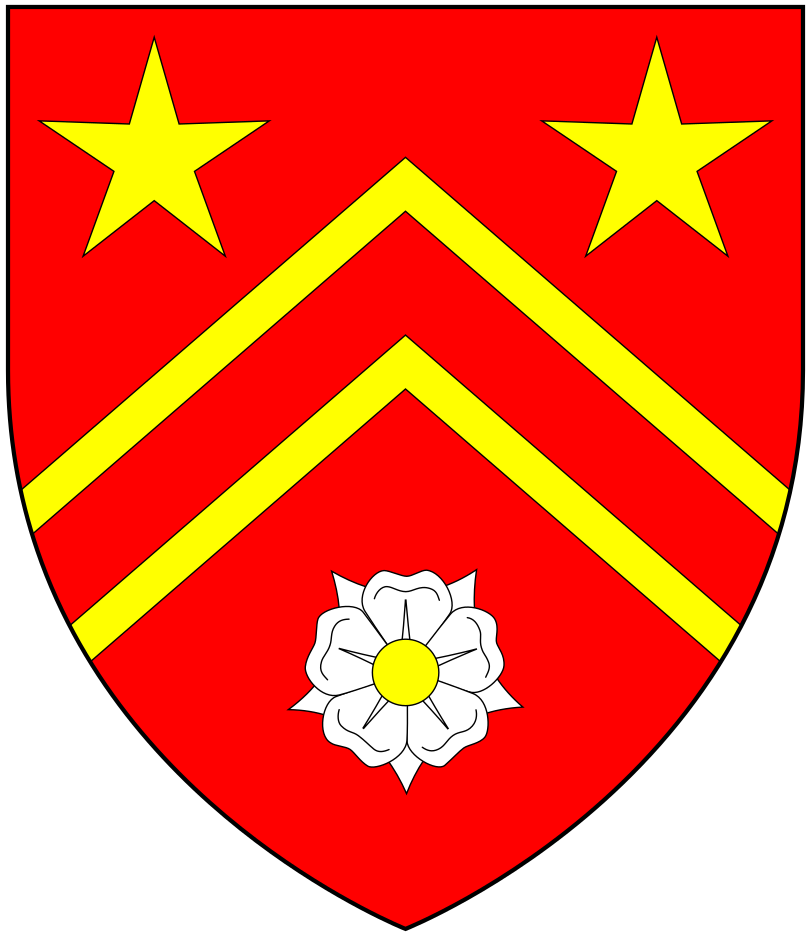Oxton, Kenton on:
[Wikipedia]
[Google]
[Amazon]



 Oxton in the parish of Kenton in South
Oxton in the parish of Kenton in South
 *Nicholas II Tripe (1711–1790) of Ashburton, was a surgeon and was the son of Nicholas I Tripe (d.1718), Vicar of
*Nicholas II Tripe (1711–1790) of Ashburton, was a surgeon and was the son of Nicholas I Tripe (d.1718), Vicar of
 In 1848 Oxton was purchased by Lt. General Edward Mortlock Studd (1799 – 6 December 1877), of Oxton, J.P. and Deputy Lieutenant for Devon,
In 1848 Oxton was purchased by Lt. General Edward Mortlock Studd (1799 – 6 December 1877), of Oxton, J.P. and Deputy Lieutenant for Devon,
Devon
Devon ( , historically known as Devonshire , ) is a ceremonial and non-metropolitan county in South West England. The most populous settlement in Devon is the city of Plymouth, followed by Devon's county town, the city of Exeter. Devon is ...
is a historic estate long held by the Martyn family, a junior branch of the Norman family of FitzMartin
FitzMartin or Fitz Martin was the surname of a Norman family based in England and Wales between 1085 and 1342.
Earliest Generations
The earliest well-documented progenitor of this family was Robert, whose charter to the monks at Montacute from ...
, feudal barons of Barnstaple.
Oxton House is a Grade II listed building
In the United Kingdom, a listed building or listed structure is one that has been placed on one of the four statutory lists maintained by Historic England in England, Historic Environment Scotland in Scotland, in Wales, and the Northern Irel ...
. The park and gardens are Grade II listed in the National Register of Historic Parks and Gardens
The Register of Historic Parks and Gardens of Special Historic Interest in England provides a listing and classification system for historic parks and gardens similar to that used for listed buildings. The register is managed by Historic England ...
.
Features
*Hermitage. Rev. Swete created a Gothic hermitage within a quarry on the estate, now a Grade II listed structure. It comprises a chamber with a small window with bench and pillow cut from the stone, reached by an arched entrance. *A picturesque ruined Gothic arch was built by Rev. Swete to the north of the lodge in about 1790, but was demolished in the mid 20th century.Descent
Martyn
The later descent of Martyn of Oxton is as follows: *SirNicholas Martyn
Sir Nicholas Martyn (12 April 1593 – 25 March 1653) was an English politician who sat in the House of Commons from 1646 to 1648.
Martyn was the son of Sir William Martyn and his wife Susan Prestwood, of Exeter. He was educated at Broadga ...
(1593–1654) of Oxton, MP for Devon
Devon ( , historically known as Devonshire , ) is a ceremonial and non-metropolitan county in South West England. The most populous settlement in Devon is the city of Plymouth, followed by Devon's county town, the city of Exeter. Devon is ...
(1646–1654) and Sheriff of Devon
The High Sheriff of Devon is the Queen's representative for the County of Devon, a territory known as his/her bailiwick. Selected from three nominated people, they hold the office for one year. They have judicial, ceremonial and administrative f ...
in 1640, whose monument survives in Kenton Church.
*William Martyn (1626–1662) of Netherexe and Oxton (son)
*Nicholas Martyn (1652–1717) of Netherexe and Oxton (son). He married Gertrude St Aubyn, daughter of John St Aubyn of Clowance, Cornwall.
*William Martyn (1680–1710) of Oxton, eldest son and heir. He inherited the estate of Holnicote in Somerset from his great aunt Susannah Martyn (d.1685), a daughter of Sir Nicholas Martyn
Sir Nicholas Martyn (12 April 1593 – 25 March 1653) was an English politician who sat in the House of Commons from 1646 to 1648.
Martyn was the son of Sir William Martyn and his wife Susan Prestwood, of Exeter. He was educated at Broadga ...
(1593–1654) and wife of Charles Staynings (1622–1700) of Holnicote. In 1705 William Martyn married a certain Susannah (d.1749).
*William Clifford Martyn (1706–1770), of Oxton, eldest son and heir, who married Elizabeth Langton (d.1753). The marriage was without progeny and on the death of William in 1770 his heir became his first cousin Nicholas II Tripe (1711–1790) of Ashburton, who actually became possessed of Oxton in 1767, according to his son Rev. Jonh Swete (d.1821).
Tripe/Swete
Chudleigh
Chudleigh () is an ancient wool town located within the Teignbridge District Council area of Devon, England between Newton Abbot and Exeter. The electoral ward with the same name had a population of 6,125 at the 2011 census.
Geography
Chudl ...
, Devon, by his wife Susannah Martyn (1681–1727), second daughter of Nicholas Martyn (1652–1717) of Oxton by his wife Gertrude St Aubyn. He became possessed of Oxton in 1767, being the heir of his cousin William Clifford Martyn (1706–1770). He married Rebecca Yarde, daughter of Gilbert Yarde by his wife Rebecca Washer.
*Rev John Swete
Rev. John Swete (born John Tripe) (baptised 13 August 1752 – 25 October 1821) of Oxton House, Kenton in Devon, was a clergyman, landowner, artist, antiquary, historian and topographer and author of the ''Picturesque Sketches of Devon'' consi ...
(1752–1821), of Oxton, eldest son and heir, born John Tripe, "a travelling observer of the picturesque
Picturesque is an aesthetic ideal introduced into English cultural debate in 1782 by William Gilpin in ''Observations on the River Wye, and Several Parts of South Wales, etc. Relative Chiefly to Picturesque Beauty; made in the Summer of the Year ...
", a classical scholar, poet, connoisseur
A connoisseur ( French traditional, pre-1835, spelling of , from Middle-French , then meaning 'to be acquainted with' or 'to know somebody/something') is a person who has a great deal of knowledge about the fine arts; who is a keen appreciator ...
of landscaping, a competent landscape artist and a topographer of Devon. He moved into Oxton in 1775 and resided there for six years at which point as he reminisced in 1792:
::"In the year 1781 I took down the old edifice...and on the self same spot I erected the present house - doing this not without due deliberation, for I then thought it was the most eligible situation on the estate, and after a lapse of ten years I think the same".
:He thus demolished the old mansion house, which he recorded in a watercolour, and built a new Georgian one on the same site.
*John Beaumont Swete (1788–1867), eldest son and heir, who married Mary Templer (1794–1886), a daughter of Henry Line Templer (1765–1818), 10th Lt Dragoons, of Lindridge House, Teigngrace
Teigngrace is a civil parish centred on a hamlet that lies about two miles north of the town of Newton Abbot in Devon, England. According to the 2001 census, its population was 235, compared to 190 a century earlier. The western boundary of the p ...
, Devon (which coincidentally was an ancient seat of the Martyn family), one of the Prince Regent
A prince regent or princess regent is a prince or princess who, due to their position in the line of succession, rules a monarchy as regent in the stead of a monarch regnant, e.g., as a result of the sovereign's incapacity (minority or illness ...
's household, whose monument exists in Teigngrace Church, by his wife Mary Rogers, daughter of Sir Frederick Leman Rogers, 7th Baronet (1782–1851). He had 15 children some of whom died young and who are commemorated on a mural tablet in Kenton Church. In the early 1830s he effected various remodelling at Oxton, but in 1848 sold it to Lt. General Edward Mortlock Studd.
Studd
Sheriff of Devon
The High Sheriff of Devon is the Queen's representative for the County of Devon, a territory known as his/her bailiwick. Selected from three nominated people, they hold the office for one year. They have judicial, ceremonial and administrative f ...
in 1862. He was the eldest son of Edward Studd (d.1813), descended from the 14th century family of Studd (''alias'' Stote) of Drinkstone in Suffolk, an officer of the East India Company
The East India Company (EIC) was an English, and later British, joint-stock company founded in 1600 and dissolved in 1874. It was formed to trade in the Indian Ocean region, initially with the East Indies (the Indian subcontinent and Southea ...
. Edward Mortlock Studd married firstly Mary Spurrier in 1820 & secondly Emma Beatrice Bayly, daughter of Lt. Charlton Booth Bayly, Royal Navy, of Sidmouth
Sidmouth () is a town on the English Channel in Devon, South West England, southeast of Exeter. With a population of 12,569 in 2011, it is a tourist resort and a gateway to the Jurassic Coast World Heritage Site. A large part of the town has ...
, Devon on 15 February 1855 at Holy Trinity, Paddington, London, by whom he had a son and heir Edward Fairfax Studd (1855–1942), of Oxton, a barrister, JP and Captain in the Royal Field Artillery, who married Evelyn Chichester (born 1854), 3rd daughter of Sir Arthur Chichester, 8th Baronet
''Sir'' is a formal honorific address in English language, English for men, derived from Sire in the High Middle Ages. Both are derived from the old French "Sieur" (Lord), brought to England by the French-speaking Normans, and which now exist i ...
, Colonel of the North Devon Yeomanry Cavalry, of Youlston Park
Youlston Park also known as Youlston House is a privately-owned 17th-century mansion house situated at Shirwell, near Barnstaple, North Devon, England. It is a Grade I listed building. The parkland is Grade II listed in the National Register of Hi ...
, Sherwell, North Devon. He also resided nearby at Exleigh, Starcross, Devon. The Lt. General's 2nd son was Alnod Ernest Studd (1857–1906), a distinguished chess player, who after a brief military career in the 15th Hussars (1875–1879) became bankrupt in 1901 through speculation on the Stock Exchange in 1882 and from a failed investment in 1891 in a coffee estate at Bundara, Mysore, India. The Studd family owned Oxton until about 1915, when it was sold to Joshua John Neale.
Neale
Joshua John Neale purchased Oxton in about 1915. He was a fish merchant and ship owner of Irish origin who in 1885 together with Henry West founded a fishmongery business in Custom House Street, Cardiff. In 1888 with West he established the Neale & West Trawler Co. In 1899 he resided at Park Road, Penarth, Glamorgan. On 6 February 1899 a steamship he half-owned named "Ramsey", registered at Cardiff, was stranded and lost on the Wolves Rocks in the Bristol Channel. In 1920 "Joshua John Neale of Oxton, Kenton, near Exeter" was listed as a County Magistrate forDinas Powis
Dinas Powys (; also spelt "Dinas Powis" in English) is a small town and community in the Vale of Glamorgan, South Wales. Its name means "fort of the provincial place" and refers to the Iron Age hillfort which overlooks the village. Dinas Powys i ...
Petty Sessional Division, in Glamorgan
, HQ = Cardiff
, Government = Glamorgan County Council (1889–1974)
, Origin=
, Code = GLA
, CodeName = Chapman code
, Replace =
* West Glamorgan
* Mid Glamorgan
* South Glamorgan
, Motto ...
, Wales. He was a student of archaeology and a naturalist and was author of "The Birds of Ireland", written before 1902 and gave a speech in Cardiff in 1917 entitled "The Survival of the Unfittest". He was a close friend of Robert Drane (d.1914), a pharmacist from Swansea who was a founding member of the Cardiff Naturalists Society in 1867, and at sometime its president, who discovered the Skomer Vole
The Skomer vole (''Myodes glareolus skomerensis'') is a subspecies of bank vole endemic to the island of Skomer, off the west coast of Wales. The bank vole was probably introduced by humans at some time after the last glaciation. It is one of ...
, was an authority on porcelain and was honorary curator of Cardiff Museum. A 1913 photograph of Neale and Drane exists in the Glamorgan Archives
The Glamorgan Archives ( cy, Archifau Morgannwg), previously known as the Glamorgan Record Office, is a county record office and repository based in Leckwith, Cardiff, Wales. It holds records for the whole of the historic county of Glamorgan but ...
, together with correspondence between the two men. More than 100 photographs of Oxton House and grounds at this time survive in the Neale family papers.
Hare
In about 1925 Oxton was purchased byRichard Granville Hare, 4th Earl of Listowel
Richard Granville Hare, 4th Earl of Listowel (12 September 1866 – 16 November 1931), known as Viscount Ennismore from 1866 to 1924, was an Irish peer and British Army officer.
Lord Ennismore was the eldest son of William Hare, 3rd Earl of ...
(1866–1931), whose father the 3rd Earl had died in 1924.
Later history
From 1938 to 1966 Oxton was used as Bletchington House School, a girls' boarding school. The house was sold in 1966 and then divided into apartments for multiple occupancy.References